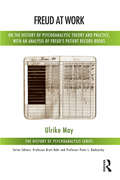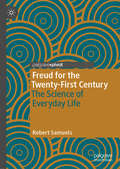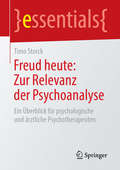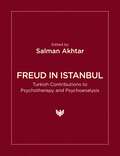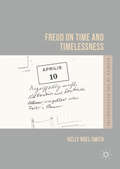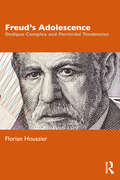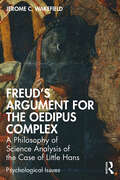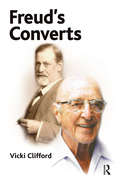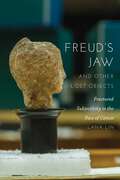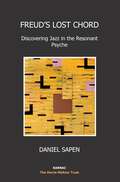- Table View
- List View
Freud as Philosopher: Metapsychology After Lacan
by Richard BoothbyUsing Jacques Lacan's work as a key, Boothby reassesses Freud's most ambitious-and misunderstood-attempt at a general theory of mental functioning: metapsychology
Freud at Work: On the History of Psychoanalytic Theory and Practice, with an Analysis of Freud's Patient Record Books (History of Psychoanalysis)
by Ulrike MayPresenting a new frame of reference, the author argues that Freud's theories are not the result of his genius alone but were developed in exchange with colleagues and students, which is not always apparent at first glance. Replete with examples, the author reconstructs who the theories were addressed to and the discursive context they originally belonged to, thus presenting fresh and surprising readings of Freud's oeuvre. The book also offers a glimpse into Freud's practice. For the first time, Freud's patient record books which he kept for ten years, are being reviewed, offering readers the hard facts about the length and frequency of Freud's analyses.
Freud for the Twenty-First Century: The Science of Everyday Life
by Robert SamuelsThis book places Freud’s theory of the reality principle in relation to both everyday experience and global issues of the 21st century and illustrates how it may be practically applied. Arguing against more critical recent accounts of Freud’s science, the author seeks to show how one might apply the scientific method to everyday life. It demonstrates how Freud contributes to a better understanding of reason and how this in turn can be used to unravel the role of unreason in both politics and personal relationships. Including critical examinations of topics such as Narcissism, Victimhood and Empathy, this engaging reappraisal of Freud’s relevance to contemporary life offers fresh insights for psychology, psychoanalysis and cultural theory; as well as practical guidance for a general reader.
Freud heute: Ein Überblick Für Psychologische Und Ärztliche Psychotherapeuten (essentials)
by Timo StorckTimo Storck prüft in diesem essential die zeitgenössische Relevanz psychoanalytischen Denkens und berührt dabei das psychoanalytische Menschenbild anhand der wichtigsten Konzepte, den Charakter der Psychoanalyse als Behandlungsverfahren sowie den Transfer psychoanalytischer Methodik auf außerklinische Bereiche, insbesondere Kunst und Kultur. Ein wichtiges Anliegen ist ihm dabei eine kritische Darstellung der Psychoanalyse „mit Freud über Freud hinaus“, sodass sich die folgende Frage stellt: Was am Freud’schen Denken behält Bestand und bewährt sich für einen Verstehenszugang des Menschen heute? Die Freud’sche Psychoanalyse gehört zu den meistdiskutierten Aspekten der mitteleuropäischen Kulturgeschichte der vergangenen rund 120 Jahre.
Freud in Cambridge
by John Forrester Laura CameronFreud may never have set foot in Cambridge - that hub for the twentieth century's most influential thinkers and scientists - but his intellectual impact there in the years between the two World Wars was immense. This is a story that has long languished untold, buried under different accounts of the dissemination of psychoanalysis. John Forrester and Laura Cameron present a fascinating and deeply textured history of the ways in which a set of Freudian ideas about the workings of the human mind, sexuality and the unconscious, affected Cambridge men and women - from A. G. Tansley and W. H. R. Rivers to Bertrand Russell, Bernal, Strachey and Wittgenstein - shaping their thinking across a range of disciplines, from biology to anthropology, and from philosophy to psychology, education and literature. Freud in Cambridge will be welcomed as a major intervention by literary scholars, historians and all readers interested in twentieth-century intellectual and scientific life.
Freud in Istanbul: Turkish Contributions to Psychotherapy and Psychoanalysis
by Salman AkhtarWith contributions from Salman Akhtar, Muge Alkan, Gulgun Alptekin, Mine Ozguroglu Cukurcesme, Yavuz Erten, Cemile Serin Gurdal, Elif Nisan Ilkmen, Ulku Elif Gurisik, Bella Habip, Cuneyt Iscan, Sureyya Iscan, T. Byram Karasu, M. Sagman Kayatekin, Z. Emel Kayatekin, Pinar Limnili Ozeren, Talat Parman, Kutlughan Soyubol, Duygu Tekgul-Akin, Isil Vahip, Vamik D. Volkan, and Ayla Yazici. The book is divided into four parts. The first looks at the history of psychoanalysis in Turkey. The second investigates the psychology of mothers, fathers, siblings, and the adolescent phase in Turkey. The third addresses the complexities and nuances of identity formation, nostalgic rumination, massive trauma, and female aggression in the context of Turkish society at large, including the use of film and literature. The fourth pertains to technical clinical issues, dealing with matters as diverse as grief, spirituality in the context of psychotherapy and psychoanalysis, tenacious maternal transferences and the handling of nonverbal material in the clinical session, to name but a few. While the book is psychoanalytic, not all contributors are analysts; many belong to other fields including psychology, sociology, psychiatry, and cultural anthropology. Thus, this is a book not only for psychoanalysts, but also for members of those fields, psychotherapists, and anyone with an interest in Turkish culture.
Freud in Zion: Psychoanalysis and the Making of Modern Jewish Identity (The History of Psychoanalysis Series)
by Eran J. RolnikFreud in Zion tells the story of psychoanalysis coming to Jewish Palestine/Israel. In this ground-breaking study psychoanalyst and historian Eran Rolnik explores the encounter between psychoanalysis, Judaism, Modern Hebrew culture and the Zionist revolution in a unique political and cultural context of war, immigration, ethnic tensions, colonial rule and nation building. Based on hundreds of hitherto unpublished documents, including many unpublished letters by Freud, this book integrates intellectual and social history to offer a moving and persuasive account of how psychoanalysis permeated popular and intellectual discourse in the emerging Jewish state.
Freud on Interpretation
by Robert W RieberThis book presents new insights into Freud's famous "discovery" of the unconscious and the subsequent development of psychoanalytic theories. The authors explore the original context in which these ideas arose and the central debate about mind as matter or something that transcends matter. In the course of this examination, it is demonstrated that Freud was influenced not only by the 19th century scientific milieu, but also by ancient cultures. While it is known that Freud was an avid collector of ancient artifacts and generally interested in these older cultures, this book systematically investigates their profound effect on his thinking and theorizing. Two major influences, Egyptian mythology and Jewish mysticism are analyzed in terms of similarities to Freud's emerging ideas about the mind and its diseases. To further this line of investigation, Bakan supplies an illuminating discussion of what it means to interpret. Taken from the viewpoint that interpretation involves an u
Freud on Time and Timelessness
by Kelly Noel-SmithTime and timelessness are fundamental principles of psychoanalysis yet Freud does not present a consolidated theory of temporality. In this book Kelly Noel-Smith pieces together Freud's scattered 'hints' and 'suspicions' about time and its negative, timelessness. She traces a careful temporal trail through Freud's published works and his daunting Nachlass, and provides a compelling reason as to why Freud kept his remarkable thoughts about time to himself.
Freud on the Couch: A Critical Introduction to the Father of Psychoanalysis
by Beverley ClackAlmost 75 years since his death, Freud remains as influential and divisive as ever. This major, new introduction argues that mistranslations, clichés, and misconceptions surround his reception. Author Beverley Clack argues that Freud was as concerned with "the death drive" as the "sex drive" and that his fierce critique of religion masked a fascination with spiritual, existential, and philosophical questions. Exploring how his life influenced his thought, plus philosophers like Schopenhauer and Nietzsche, Clack updates all of Freud's key ideas and case studies and highlights why his work remains relevant.
Freud the Man: An Intellectual Biography
by Lydia FlemThe world knows Freud as a thinker--one of the founding giants of modern culture. Now Lydia Flem paints a unique and unforgettable portrait of Frued the man: a father, husband, and friend, a secular Jew with passion for classical antiquity and European culture, torn between his need to be fully accepted in an anitsemitic society while remaining fatihful to his orgins.Flem enters into the depths of Freud's creativity, showing how his thinking is connected to his immersion in the arts, the history of religions, and mythology. The intimate details of his daily life, his relationships with women, his poetic gifts, his travels, his dreams, his letters to family, friends, and colleagues: all reveal his vision of the unconscious. We accompany Freud on his walks through Vienna and Rome; look over his shoulder as he writes to his fiancee; learn the significance of the Greek, Roman, and Egyptian figurines that stand before him on his desk as he conceives his groundbreaking ideas; and discover the books, read in childhood, that later shape his self-analysis and his theoretical development.Flem draws on an unusually broad range of sources, but she wears her learning lightly: her biography of Freud reads like a novel, full of vivid details and captivating human interest. From the 6-year-old gleefully tearing up a book illustrated with pictures of Persia; to the young doctor balancing his scientific training with his love of Shakespeare; to the psychoanalyst in his prime, conquering the resistance to his theories; to the old man, ravaged by illness, forced to flee into exile in England, Lydia Flem leads us deep into the life of a genius.
Freud's 'Outstanding' Colleague/Jung's 'Twin Brother': The suppressed psychoanalytic and political significance of Otto Gross
by Gottfried M. HeuerOtto Gross was the first analyst to link his work with radical politics, connecting inner, personal transformation with outer, collective change. Since his death in 1920 his work has been suppressed, despite his seminal influence on the developing analytic discipline and on the fields of sociology, philosophy and literature. Here Gottfried M. Heuer introduces Gross’ life and ideas, using an innovative, historiographic methodology he terms trans-historical: a psychoanalytic, intersubjective, and trans-temporal approach to the past, aimed at ‘healing wounded history’ in the present. Heuer considers several previously unpublished sources to explore Gross’s ideas and legacy as well as his unusually bohemian life. His use of the anarchist concept of mutuality to develop a relational and intersubjective approach in his own analytic theory and clinical practice was unique, and his work had a lasting, yet unacknowledged, influence on Freud, Jung (with whom he had the first recorded mutual analysis) and many other analysts. His ideas were appropriated by Max Weber, the founder of sociology, and by the philosopher Martin Buber, playing a pivotal role in what we now call ‘modernity’. Heuer also explores Gross’s paradigmatic father/son battle with his father Hans, who established the science of criminology, and touches upon Gross’s links to the literary field of the early 20th century via Kafka, Werfel, et al., German expressionism and the Dada-movement, as well as the Anglo-American world through the work of D. H. Lawrence. This innovative, multi-faceted approach to Gross’s work and its influence marks a turning point, putting him firmly on the map of the historiography of analysis as well as linking this field with the neighbouring disciplines of the history of law and criminology, literature, sociology and philosophy. In addition, Gross continuing relevance for leading edge clinical and political ideas is addressed. This book will be essential reading for Jungian and Freudian analysts, psychotherapists and counsellors, academics and students of analysis, politics, history, criminology and sociology.
Freud's Adolescence: Oedipus Complex and Parricidal Tendencies
by Florian HoussierIn Freud’s Adolescence, Florian Houssier looks at the early years of the Father of Psychoanalysis and considers how his personal experiences shaped his later work. Including excerpts from many letters written by Freud himself, this volume allows a rare glimpse into the inner thoughts and emotions of one of his generation’s greatest minds. Engaging with this lesser-known period of Freud’s life, the vivacity of his incestuous and parricidal fantasies comes to the surface, infiltrating his relational life as well as his dreams. Houssier proposes a new hypothesis about the conflicts of Freud’s adolescence, and their impact on his tendencies in later conflicts. This is the first book that sustains a systematic analysis of this material and adds a new dimension to the biography of Freud by exploring links between his life and creativity from a current theorisation of the adolescent process. This book will be an essential read for all psychoanalysts, psychologists, lecturers, followers of Freud’s work and those looking into psychoanalysis as a whole.
Freud's Argument for the Oedipus Complex: A Philosophy of Science Analysis of the Case of Little Hans (Psychological Issues)
by Jerome C. WakefieldIn this close reading of Freudian theory, Jerome C. Wakefield reconstructs Freud’s argument for the Oedipal theory of the psychoneuroses, placing the case of Little Hans into a philosophy-of-science context and critically rethinking the epistemological foundations of psychoanalysis. Wakefield logically evaluates four central Freudian arguments: the "undirected anxiety" argument which contends that Hans suffered from anxiety before he developed his horse phobia; the "day the horse fell down" argument where, engaging in some scholarly detective work, Wakefield resolves a century-old dispute between behaviorists and psychoanalysts about when Hans witnessed a frightening horse accident; the "N=1 sexual repression" argument that the trajectory of Hans’s sexual desires matches the Oedipal theory’s predictions; and lastly, the "detailed symptom characteristics" argument that the Oedipal theory is needed to understand otherwise inexplicable details of Hans’s symptoms. Wakefield demonstrates that, although Freud’s arguments are brilliantly conceived, he misread the facts of the Hans case and failed to support the Oedipal theory as judged by his own stated evidential standards. However, this failure creates an opportunity for renewed consideration of psychoanalysis’s distinctive contribution: the understanding of an individual’s unique meaning system and confrontation with meanings outside of focal awareness in order to reshape an individual’s fate. This book will be of interest to psychoanalysts and psychotherapists alike, and will prove essential for scholars working in the fields of psychoanalysis, philosophy of science, and the history of psychiatry.
Freud's Art - Psychoanalysis Retold
by Janet SayersIn Freud's Art – Psychoanalysis Retold Janet Sayers provides a refreshing new introduction to psychoanalysis by retelling its story through art. She does this by bringing together experts from psychoanalysis, art history, and art education to show how art and psychoanalysis illuminate each other. Freud's Art begins with major founders of psychoanalysis - Freud, Jung, Spielrein and Klein. It then details art-minded developments of their ideas by Adrian Stokes, Jacques Lacan, Marion Milner, Anton Ehrenzweig, Donald Winnicott, and Wilfred Bion before concluding with the recent theories of Jean Laplanche and Julia Kristeva. The result is a book which highlights the importance of psychoanalysis, together with painting and the visual arts, to understanding the centrality of visual imagery, fantasy, nightmares and dreams to all of us, artists and non-artists alike. Illustrated throughout with fascinating case histories, examples of well known and amateur art, doodles, drawings, and paintings by both analysts and their patients, Freud's Art provides a compelling account of psychoanalysis for all those studying, working in, or simply intrigued by psychology, mental health and creativity today.
Freud's Beasty Boys: Sex, Violence and Masculinity
by Oxana TimofeevaThis book examines violence and sexuality after Freud. Its characters, though, are not women and men, but rather animals and children. Focusing on three famous Freudian cases in which little boys had issues with animals – Little Hans, The Rat Man, and the Wolf Man – it revises the role played by animals in male gender socialization. Timofeeva demonstrates the relevance of psychoanalysis for anyone who wants to understand how patriarchy works, but she also points to its limitations. For Freud, sexuality creates the background of our psychic lives, and unconscious sexual fantasies are the origins of psychic disorders such as hysteria, obsessions and phobias. But what are the origins of sexual fantasies? Timofeeva argues that behind psychic dramas of sexuality there is something else: a mechanism of violence which she calls ‘the machine of masculinity’ and which she analyses both through Freud’s cases and through the lens of religion, anthropology and her own life experiences. Wolves, rats and horses are magical agents that connect us to the world of the dead – that is, to the history of our culture in which monotheism replaced totemic practices but the basic psychosocial matrix of turning love into violence continues to reproduce itself.
Freud's Converts
by Vicki CliffordThis work is an exploration of the relationship which psychotherapy has with religion. Sigmund Freud and Carl Rogers were chosen for this exposition because they were each seduced by the high status given to science. Freud and Rogers, both founders of psychotherapies, left a legacy which is not that of scientists whom they claimed they were. Freud and Rogers each had a problematic relationship with religion. This has had a lasting effect on the work and attitudes of their respective followers. In order to explore effectively this relationship, the work begins with a critical examination of the historical context in which both Freud and Rogers worked, and how in their determination to be scientists both missed the importance of the religious. The work continues with an exploration of the effects of this legacy on the work of contemporary psychotherapists. The context in which their followers work relies on a relationship with the founder, which goes beyond that of science, and in addition, each practitioner is influenced by socio-economic circumstances which are peculiar to them. The resistance from psychotherapists to embrace religion has been complex, although, as it will be illustrated, today there are some who are acknowledging the importance of the spiritual. That psychotherapy functions as a religious movement has been excluded by practitioners in their determination to reflect the wishes of their founder, which was that their work should be regarded as science. Psychotherapists have traditionally been considered the custodians of the real and that their clients are the ones suffering from delusions. With respect to their attitudes to religion–not least the spiritual–the positions seem to be reversed.
Freud's Early Psychoanalysis, Witch Trials and the Inquisitorial Method: The Harsh Therapy
by Kathleen DuffyIn Freud’s Early Psychoanalysis, Witch Trials and the Inquisitorial Method: The Harsh Therapy, author Kathleen Duffy asks why Freud compared his ‘hysterical’ patients to the accused women in the witch trials, and his ‘psychoanalytical’ treatment to the inquisitorial method of their judges. He wrote in 1897 to Wilhelm Fliess: ‘I ... understand the harsh therapy of the witches’ judges’. This book proves that Freud’s view of his method as inquisitorial was both serious and accurate. In this multidisciplinary and in-depth examination, Duffy demonstrates that Freud carefully studied the witch trial literature to develop the supposed parallels between his patients and the witches and between his own psychoanalytic method and the judges’ inquisitorial extraction of ‘confessions’, by torture if necessary. She examines in meticulous detail both the witch trial literature that Freud studied and his own case studies, papers, letters and other writings. She shows that the various stages of his developing early psychoanalytic method, from the 'Katharina' case of 1893, through the so-called seduction theory of 1896 and its retraction, to the 'Dora' case of 1900, were indeed in many respects inquisitorial and invalidated his patients’ experience. This book demonstrates with devastating effect the destructive consequences of Freud’s nineteenth-century inquisitorial practice. This raises the question about the extent to which his mature practice and psychoanalysis and psychotherapy today, despite great achievements, remain at times inquisitorial and consequently untrustworthy. This book will therefore be invaluable not only to academics, practitioners and students of psychoanalysis, psychotherapy, literature, history and cultural studies, but also to those seeking professional psychoanalytic or psychotherapeutic help.
Freud's Free Clinics
by Elizabeth Ann DantoToday many view Sigmund Freud as an elitist whose psychoanalytic treatment was reserved for the intellectually and financially advantaged. However, in this new work Elizabeth Ann Danto presents a strikingly different picture of Freud and the early psychoanalytic movement. Danto recovers the neglected history of Freud and other analysts' intense social activism and their commitment to treating the poor and working classes.Danto's narrative begins in the years following the end of World War I and the fall of the Habsburg Empire. Joining with the social democratic and artistic movements that were sweeping across Central and Western Europe, analysts such as Freud, Wilhelm Reich, Erik Erikson, Karen Horney, Erich Fromm, and Helene Deutsch envisioned a new role for psychoanalysis. These psychoanalysts saw themselves as brokers of social change and viewed psychoanalysis as a challenge to conventional political and social traditions. Between 1920 and 1938 and in ten different cities, they created outpatient centers that provided free mental health care. They believed that psychoanalysis would share in the transformation of civil society and that these new outpatient centers would help restore people to their inherently good and productive selves.Drawing on oral histories and new archival material, Danto offers vivid portraits of the movement's central figures and their beliefs. She explores the successes, failures, and challenges faced by free institutes such as the Berlin Poliklinik, the Vienna Ambulatorium, and Alfred Adler's child-guidance clinics. She also describes the efforts of Wilhelm Reich's Sex-Pol, a fusion of psychoanalysis and left-wing politics, which provided free counseling and sex education and aimed to end public repression of private sexuality.In addition to situating the efforts of psychoanalysts in the political and cultural contexts of Weimar Germany and Red Vienna, Danto also discusses the important treatments and methods developed during this period, including child analysis, short-term therapy, crisis intervention, task-centered treatment, active therapy, and clinical case presentations. Her work illuminates the importance of the social environment and the idea of community to the theory and practice of psychoanalysis.
Freud's Free Clinics: Psychoanalysis and Social Justice, 1918–1938
by Elizabeth Ann DantoToday many view Sigmund Freud as an elitist whose psychoanalytic treatment was reserved for the intellectually and financially advantaged. However, in this new work Elizabeth Ann Danto presents a strikingly different picture of Freud and the early psychoanalytic movement. Danto recovers the neglected history of Freud and other analysts' intense social activism and their commitment to treating the poor and working classes.Danto's narrative begins in the years following the end of World War I and the fall of the Habsburg Empire. Joining with the social democratic and artistic movements that were sweeping across Central and Western Europe, analysts such as Freud, Wilhelm Reich, Erik Erikson, Karen Horney, Erich Fromm, and Helene Deutsch envisioned a new role for psychoanalysis. These psychoanalysts saw themselves as brokers of social change and viewed psychoanalysis as a challenge to conventional political and social traditions. Between 1920 and 1938 and in ten different cities, they created outpatient centers that provided free mental health care. They believed that psychoanalysis would share in the transformation of civil society and that these new outpatient centers would help restore people to their inherently good and productive selves.Drawing on oral histories and new archival material, Danto offers vivid portraits of the movement's central figures and their beliefs. She explores the successes, failures, and challenges faced by free institutes such as the Berlin Poliklinik, the Vienna Ambulatorium, and Alfred Adler's child-guidance clinics. She also describes the efforts of Wilhelm Reich's Sex-Pol, a fusion of psychoanalysis and left-wing politics, which provided free counseling and sex education and aimed to end public repression of private sexuality.In addition to situating the efforts of psychoanalysts in the political and cultural contexts of Weimar Germany and Red Vienna, Danto also discusses the important treatments and methods developed during this period, including child analysis, short-term therapy, crisis intervention, task-centered treatment, active therapy, and clinical case presentations. Her work illuminates the importance of the social environment and the idea of community to the theory and practice of psychoanalysis.
Freud's Interpretation of Dreams: A Reappraisal
by Susan SugarmanFreud always regarded The Interpretation of Dreams, and in particular its thesis that dreams fulfill wishes, as his landmark contribution and the scaffolding of his subsequent work. Susan Sugarman, after carefully examining the text and scrutinizing a range of Freud's other works, shows that the dreams book is not and cannot be that scaffolding. For, not only does his argument on dreams falter, but his reasoning elsewhere – in his case histories, his accounts of phenomena of ordinary waking life, and even his avowedly speculative writing – displays a strength and precision his account of dreams lacks. She concludes by exploring what is then left of the dreams theory and Freud's overall vision of the mind.
Freud's Jaw and Other Lost Objects: Fractured Subjectivity in the Face of Cancer
by Lana LinWhat does it mean to live with life-threatening illness? How does one respond to loss? Freud’s Jaw and Other Lost Objects attempts to answer these questions and, as such, illuminates the vulnerabilities of the human body and how human beings suffer harm. In particular, it examines how cancer disrupts feelings of bodily integrity and agency. Employing psychoanalytic theory and literary analysis, Lana Lin tracks three exemplary figures, psychoanalyst Sigmund Freud, poet Audre Lorde, and literary and queer theorist Eve Kosofsky Sedgwick. Freud’s sixteen-year ordeal with a prosthetic jaw, the result of oral cancer, demonstrates the powers and failures of prosthetic objects in warding off physical and psychic fragmentation. Lorde’s life writing reveals how losing a breast to cancer is experienced as yet another attack directed toward her racially and sexually vilified body. Sedgwick’s memoir and breast cancer advice column negotiate her morbidity by disseminating a public discourse of love and pedagogy. Lin concludes with an analysis of reparative efforts at the rival Freud Museums in London and Vienna. The disassembled Freudian archive, like the subjectivities-in-dissolution upon which the book focuses, shows how the labor of integration is tethered to persistent discontinuities.Freud’s Jaw asks what are the psychic effects of surviving in proximity to one’s mortality, and it suggests that violences stemming from social, cultural, and biological environments condition the burden of such injury. Drawing on psychoanalyst Melanie Klein’s concept of “reparation,” wherein constructive forces are harnessed to repair damage to internal psychic objects, Lin proposes that the prospect of imminent destruction paradoxically incites creativity. The afflicted are obliged to devise means to reinstate, at least temporarily, their destabilized physical and psychic unity through creative, reparative projects of love and writing.
Freud's Legacy in the Global Era (Relational Perspectives Book Series)
by Carlo StrengerFreud’s Legacy in the Global Era presents a radically new perspective on Freud’s relevance today as a forerunner of the contemporary evolutionary neurosciences also steeped in the tradition of humanistic thought. Carlo Strenger shows how globalisation has produced new theoretical, practical and clinical issues for psychoanalysis, which can best be understood by drawing on influences from economics, sociology and philosophy. Strenger’s lively case histories demonstrate a new psychoanalytic viewpoint engaged with surrounding scientific disciplines in an enriching interchange, and open to the fascinating cultural and social developments that shape patients’ reality, lives and concerns in a global era. This book will be of interest to psychoanalysts, psychoanalytic and psychodynamically oriented psychotherapists and to all mental health professionals interested in the interaction of psychoanalysis and other disciplines from a global viewpoint as well as to lay readers keen to understand the complexity of globalized life.
Freud's Lost Chord: Discovering Jazz in the Resonant Psyche
by Daniel SapenIn Freud's Lost Chord, Dan Sapen explores what it means for the development of depth psychology that Freud was perplexed by music, and unlike nearly every other aspect of human life, had little to say about it - a problem shared by most others in the early generations of psychoanalytic thought. Psychoanalyst Charles Rycroft wrote One cannot help regretting that none of the pioneers of the unconscious thought naturally in auditory terms; more than this, over 100 years later, not only is music per se rarely looked it in psychodynamic terms, jazz music is almost completely absent from the literature. Dr. Sapen looks in depth at the intricate details of psychodynamic theory and practice, as well as an overview of its development, to address the possibility that a theoretical model that has little to say about such a basic and omni-present aspect of human life must be seriously flawed in its effort to explain what it is to be human, and how the mind functions and what it creates. However, Sapen illustrates how numerous other thinkers (Jung, Winnicott, Bion, Loewald, Rycroft), some seemingly at odds with and others serving as essential developments and re-workings of psychoanalytic principles, have managed to illuminate and integrate those missing principles so basic to music and creativity - to development, dreaming, thinking, and relating among other human beings intimately and in a society. Nearly uniquely in the psychodynamic literature, Sapen looks in depth at the music of Miles Davis and John Coltrane as examples of the living, breathing psychological processes so essential to understanding the meaning and dynamics of being human that Freud could not, for a variety of reasons, conceptualize.
Freud's Models of the Mind: An Introduction (The\psychoanalytic Monograph Ser. #Vol. 1)
by Alex Holder Joseph Sandler Christopher Dare Anna Ursula DreherThe authors succeed in putting Freud's models of the mind into a historical and developmental framework and show the complexity of his thinking on the relationship between the conscious and unconscious mind.

